
The Aachen Town Hall (German : Bremer Rathaus) is a landmark of cultural significance located in the Altstadt of Aachen, Germany. It was built in the Gothic architecture style in the first half of the 14th century.

The Aachen Town Hall (German : Bremer Rathaus) is a landmark of cultural significance located in the Altstadt of Aachen, Germany. It was built in the Gothic architecture style in the first half of the 14th century.


Aachen Town Hall was built in the first half of the 14th century under the leadership of the mayor Gerhard Chorus (1285 – 1367). The new hall also hosted the traditional coronation feast that was part of the coronation ceremony of the Holy Roman Empire. Before that, the coronation was held at the nearby mid-13th century Grashaus which is one of the city’s oldest still-standing buildings nowadays. Construction began in 1330 on top of the foundation walls of the Aula Regia, part of the derelict Palace of Aachen, built during the Carolingian dynasty. Dating from the time of Charlemagne, the Granus Tower and masonry from that era were incorporated into the south side of the building.[1] The structure was completed in 1349, and while the town hall served as the administrative center of the city, part of the city’s munitions and weaponry was housed in the Granus Tower, which also served as a prison for some time. [1]

Since 1380, the entrance of "Emperor's stairs" (Kaisertreppe), which connected the subterranean levels to the Coronation Hall, was adorned by the limestone relief of the Three Kings and a depiction of the Adoration of the Magi. Four limestone blocks formed the relief, with one serving for each king, and the last depicting Mary and Jesus.
In 1798, during the French period, the relief was partially destroyed, and the remaining pieces were left as they were above the entrance to the main guard station. [2] The medieval artwork was then replaced by Gottfried Götting with a replica in 1879. Before World War II, it was then transferred to the local museum (Heimatmuseum) in Aachen and disappeared during the war time.

During the Great Fire of Aachen in 1656, [3] portions of the roof and towers burned. The destroyed elements were then replaced in a baroque style. [4] From 1727 to 1732 the Chief Architect of Aachen, Johann Joseph Couven, led a fundamental baroque remodeling of the structure, especially of the front façade and entry steps. The gothic figures and muntin adorning the windows were removed, and even the interior was remodeled in the baroque style. Today, the sitting room and the "White Hall" both still convey this change in style.
Characteristic of the time period, the wood paneling of the White Hall is in the style of Aachen-Liège baroque master Jacques de Reux, while the wall painting comes from master painter Johann Chrysant Bollenrath. This hall was originally for a panel of jurists who controlled the quality of cloth produced in Aachen, but the space would later serve as the main office for the mayor of Aachen.
At the treaty signing ceremony that ended the War of Austrian Succession in 1748, the "Peace Hall" was set up but was not used because of a dispute between the envoys. As a compensation, the city obtained portraits of the envoys, which are present in the various spaces of the City Hall.
Since the end of the imperial city era and the Napoleonic occupation of the area, the structural condition of the City Hall was neglected and the building was seen to be falling apart by 1840. Under the guidance and patronage of the 19th century Chief Architect Friedrich Joseph Ark, the building was rebuilt in a neogothic style preserving its original Gothic elements. The side of the City Hall that faced the Market was adorned with statues of 50 kings, as well as symbols of art, science, and Christianity.
The Coronation Hall was also restored and a new entrance was constructed. In addition, the painter Alfred Rethel had the task to embellish the room with a large series of frescoes. Begun in 1847 and completed by his student in 1861, the frescoes eventually depicted legends from the life of Charlemagne. After the destruction of similar artwork at the Neues Museum in Berlin, this painting is one of the most important testimonies to the late romantic style in Germany.

Starting from a fire in the Johann Peter Joseph Monheim Drug and Material Warehouse at 26 Antonius Street ( Antoniusstraße ), flames first spread when cinder from the roof landed on the Granus Tower and set it ablaze. [5] Within four hours the roof and both towers of the City Hall were aflame, as were a large number of surrounding houses on the south side of the Market. Within City Hall, the Coronation Hall with its frescoes by Alfred Rethel, as well as the building's first floor, was spared. In the time immediately following the fire, its roof and towers were kept erect through makeshift structures of support.
On 1 November 1884, the city of Aachen started a contest among German architects for the purpose of rebuilding the City Hall. Out the 13 submitted draft designs, the first prize went to Aachen architect Georg Frentzen, who in 1891 was commissioned to rebuild the building and its towers. The restoration of the inner rooms was performed under the leadership of Joseph Laurent. In 1895, the sculptures depicting the Knight Gerhard Chorus and Johann von Punt (Aachen's mayor from 1372 to 1385) were reinstalled in the bay windows on the back side of City Hall while the eight shields depicting the coat of arms of medieval nobility (Margarten, Berensberg, Roide, Hasselholz, Surse, Wilde, Joh Chorus, and Zevel) were remade in the spandrels. The work was accomplished by Karl Krauß. The restoration took 18 years to complete (finished in 1902) after the unveiling of the Rathaus took place with the presence of Kaiser Wilhelm II, Emperor of Germany, on 19 June 1902.
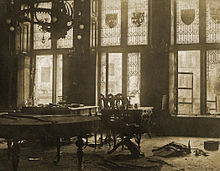
Aachen’s city hall survived World War I without sustaining damage, but during the civil unrest in the Rhenish Republic period, the City Hall was stormed by a group of separatists who caused serious damage both to its interior and exterior. [6]
During the World War II, Aachen City Hall was heavily damaged by bombing raids, especially those occurring on 14 July 1943 and 11 April 1944. On 14 July 1943, the roof of the building and both towers burned, and afterwards the structure retained a distinctive shape due to the heat that twisted the steel skeletons inside the tower caps. The Coronation Hall was also heavily damaged and the north facing wall was moved in places up to 30 centimeters vertically. The imminent threat of collapse was staved off through the use of emergency beams that held the structure in place. Because of rain penetrating the interior of the building as well its frescoes were severely affected. Five of the eight frescoes were removed by Franz Stiewi and stored at the Suermondt-Ludwig-Museum.
In 1945, the architect Otto Gruber and the engineer Richard Stumpf prepared a report on the structural integrity of the building. With the help of Professor Josef Pirlet, the dilapidated north façade was reinforced with steel and tension bars, and in 1946, the building’s roof was repaired by using makeshift sheets of zinc. After structural analysis was conducted and the foreground reinforced, the replacement of the north façade took place (since almost all of the arches there were broken). The arches on the ground floor were again closed for repairs in 1950, and the reconstruction of the Emperor Hall was largely completed by 1953, with the configuration of the room following in the next few years.
The question of how the tower caps should be rebuilt remained at the heart of a controversial discussion. In 1966 Professor Wilhelm K. Fischer, who greatly contributed to the reconstruction of Aachen, wrote a draft for the towers’ design. The students from RWTH Aachen University also took part in the debate, submitting 24 designs for consideration. In 1968 eight additional expert designs were submitted to a working group whose mission was to rebuild the towers and, after discussing several modern samples, the group agreed on a design proposed by the conservation-restoration expert Leo Hugot, who insisted on the historical image of the towers. The tower caps were finally finished in 1978.

Nowadays, the replicas of the Imperial Regalia from the Viennese Imperial Treasury are located in the city hall. The replicas were made around 1915 by order of Emperor Wilhelm II for an exhibition to commemorate 31 coronations that took place in Aachen between 813 and 1531. The replicas include the copy of the Vienna Coronation Gospels, the Sabre of Charlemagne, the Imperial Crown of Otto I, and the Imperial Orb.
Since 2009, Aachen City Hall has been a part of the Route Charlemagne, a tour program by which historical sights of Aachen are presented to visitors. At the city hall, a museum exhibition explains the history and art of the building and gives a sense of the historical coronation banquets that took place in the past. Among the replicas, the tourists can also discover the portrait of Napoleon from 1807 by Louis-André-Gabriel Bouchet and one of his wife Joséphine from 1805 by Robert Lefèvre. The city hall is still the residence of the mayor of Aachen and of the city council. The annual Charlemagne Prize is awarded in the City Hall of Aachen.
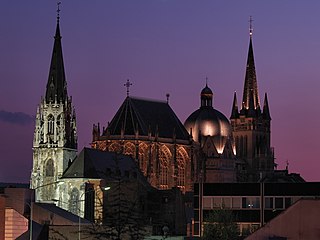
Aachen is the 13th-largest city in North Rhine-Westphalia and the 27th-largest city of Germany, with around 249,000 inhabitants.

Aachen Cathedral is a Roman Catholic church in Aachen, Germany and the seat of the Roman Catholic Diocese of Aachen.

Ripuarian is a German dialect group, part of the West Central German language group. Together with the Moselle Franconian which includes the Luxembourgish language, Ripuarian belongs to the larger Central Franconian dialect family and also to the Rhinelandic linguistic continuum with the Low Franconian languages.

Burtscheid Abbey was a Benedictine monastery, after 1220 a Cistercian nunnery, located at Burtscheid, near Aachen, North Rhine-Westphalia, in Germany.

The Great Saint Martin Church is a Romanesque Catholic church in Cologne, Germany. Its foundations rest on remnants of a Roman chapel, built on what was then an island in the Rhine. The church was later transformed into a Benedictine monastery. The current buildings, including a soaring crossing tower that is a landmark of Cologne's Old Town, were erected between 1150-1250. The architecture of its eastern end forms a triconch or trefoil plan, consisting of three apses around the crossing, similar to that at St. Maria im Kapitol. The church was badly damaged in World War II; restoration work was completed in 1985.
The Lower Rhenish Music Festival was one of the most important festivals of classical music, which happened every year between 1818 and 1958, with few exceptions, at Pentecost for 112 times.

The Karolus magnus et Leo papa, sometimes called the Paderborn Epic or the Aachen Epic, is a Carolingian Latin epic poem of which only the third of four books is extant. It recounts the meeting of Charlemagne, king of the Franks, with Pope Leo III, in AD 799.


The following is a timeline of the history of the city of Aachen, Germany.

The Barbarossa Chandelier was made on the order of Emperor Frederick I, nicknamed Barbarossa, and his wife Beatrice sometime between 1165 and 1170 and was installed under the cupola of the Palatine Chapel in Aachen Cathedral. The chandelier was a donation in honour of Mary, Mother of God, the patroness of Aachen Cathedral and simultaneously represented a tribute to the builder of the cathedral, Charlemagne.

The Throne of Charlemagne is a throne erected in the 790s by Charlemagne, as one of the fittings of his palatine chapel in Aachen and placed in the Octagon of the church. Until 1531, it served as the coronation throne of the King of the Romans, being used at a total of thirty-one coronations. As a result, especially in the eleventh century, it was referred to as the totius regni archisolium. Charlemagne himself was not crowned on this throne, but instead in the Old St. Peter's Basilica in Rome by Pope Leo III in 800 AD.
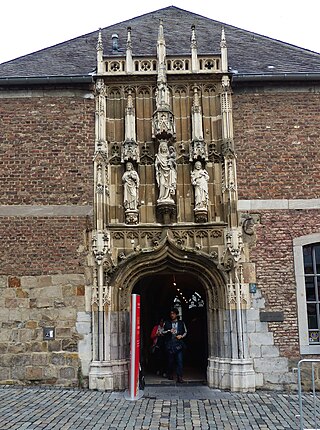
The Aachen Cathedral Treasury is a museum of the Roman Catholic Diocese of Aachen under the control of the cathedral chapter, which houses one of the most important collections of medieval church artworks in Europe. In 1978, the Aachen Cathedral Treasury, along with Aachen Cathedral, was the first monument on German soil to be entered in the List of UNESCO World Heritage Sites. The treasury contains works from Late Antique, Carolingian, Ottonian, Staufen, and Gothic times. The exhibits are displayed in premises connected to the cathedral cloisters.

The Town Hall of Osnabrück, Germany, was built in the late Gothic style from 1487 to 1512. It is one of Osnabrück's most important buildings and emblems and continues to be used as the city's town hall today. The Treaty of Westphalia was negotiated and signed by the combatants of the Thirty Years’ War at the town halls of Osnabrück and Münster in 1648.
Heinz Hubert Baumann was a German Roman-Catholic priest in Aachen.
The Sinfonieorchester Aachen is the concert and opera orchestra of the Theater Aachen. It consists of about 70 musicians and performs about 140 times a year. The regular symphony concerts take place in the Eurogress Aachen.
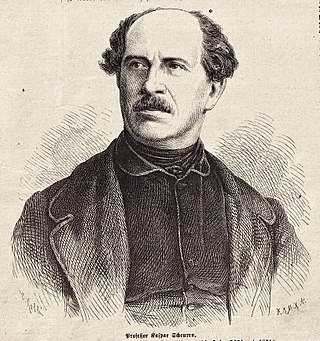
Caspar Johann Nepomuk Scheuren was a German painter and illustrator.
Willy Weyres was a German architect and academic teacher. He was Kölner Dombaumeister from 1944 to 1972, diocesan master builder for the Archdiocese of Cologne for more than ten years, and full professor of architectural history and monument preservation at the RWTH Aachen from 1955 until his retirement in 1972. Under his leadership, the Cologne Cathedral was restored and further developed after the Second World War.
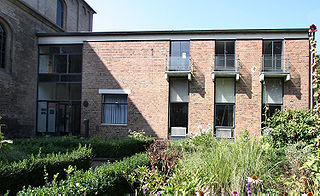
Karl Friedrich Heinrich Band was a German architect.

Eduard Adolf Daelen was a German painter and writer. For some of his writings he used the pseudonyms Ursus teutonicus, Angelo Dämon, Edu Daelen-Bachem and Michel Bär. He became known above all for the first biography of Wilhelm Busch, which he wrote in 1886.

The Old Town Hall, which dominates the east side of the marketplace in Leipzig's district Mitte, is considered one of Germany's most important secular Renaissance buildings. At the rear is the Naschmarkt. The mayor and the municipal administration have been housed in the New Town Hall since 1905.